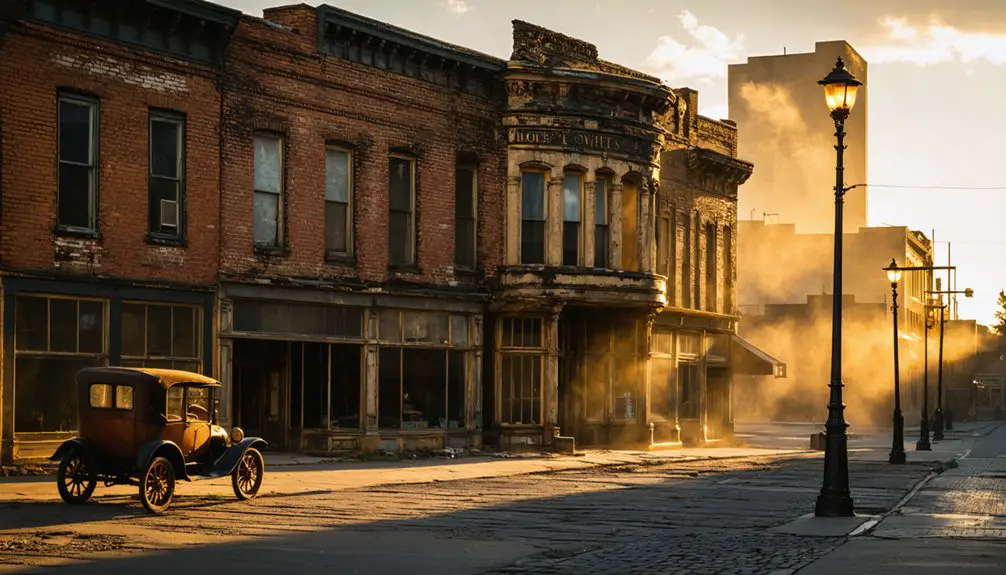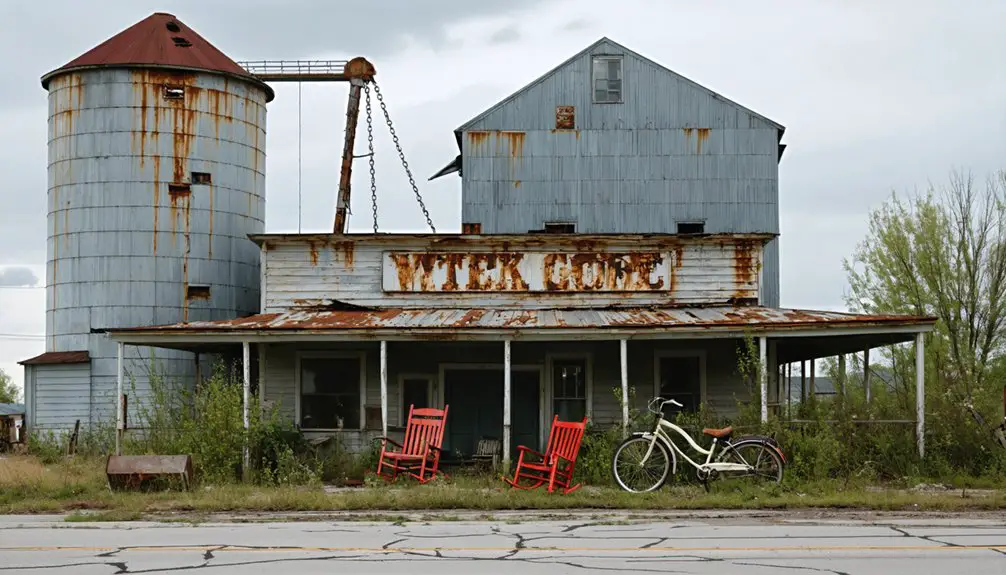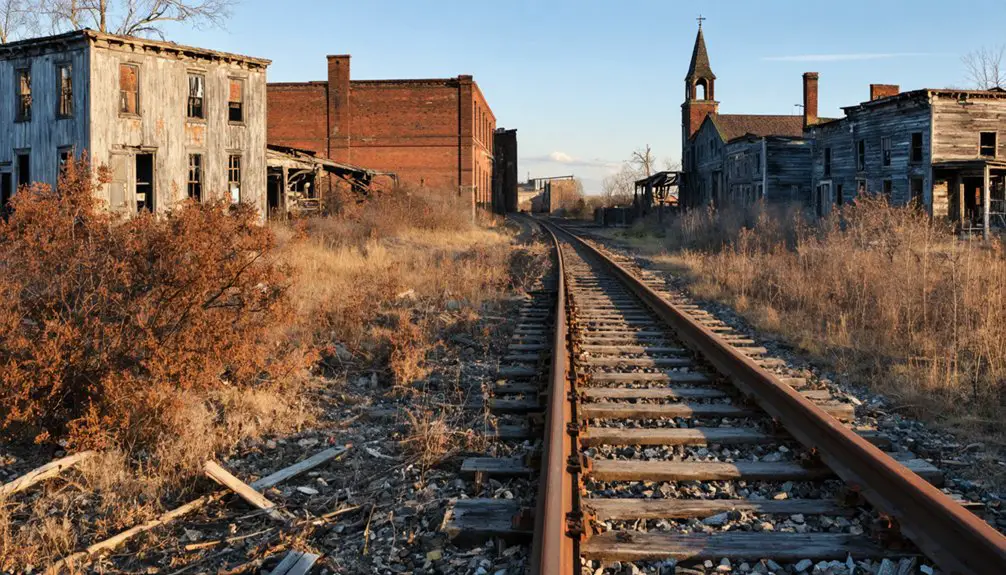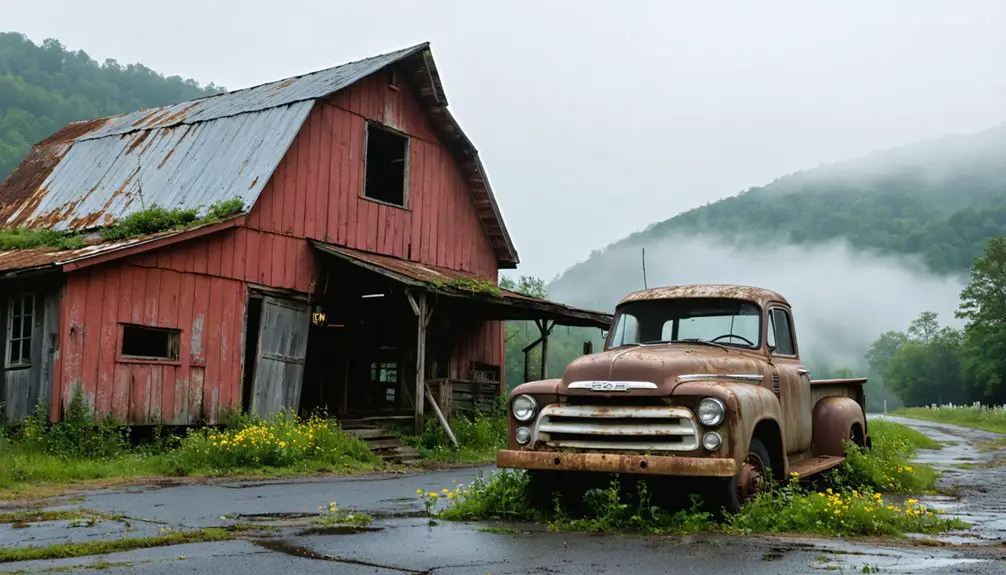You’ll find Hicksville’s haunting story in Pennsylvania’s coal country, where 180,000 miners once worked the region’s five major mines. After the 1929 stock market crash forced mine closures, desperate residents turned to dangerous illegal mining. By 1962, underground fires created toxic fumes and sinkholes, prompting a mass exodus. Government buyouts in the 1990s sealed the town’s fate, leaving behind empty streets and demolished buildings – though a few determined residents refused to leave.
Key Takeaways
- Once-thriving coal mining town established by Lehigh Coal & Navigation Company in 1822, supporting multiple generations through mining operations.
- Underground fires in 1962 forced mass evacuation due to toxic fumes and dangerous sinkholes developing beneath homes.
- Stock Market Crash of 1929 devastated local mines, leading to widespread unemployment and illegal mining operations.
- Government buyout programs in the 1990s accelerated population exodus, transforming Hicksville from thousands of residents to near abandonment.
- Environmental hazards from mine fires and ground instability left empty streets and demolished buildings, with only a few determined residents remaining.
The Rise of a Mining Community
Everything changed when the Lehigh Coal & Navigation Company emerged in 1822, transforming community dynamics through massive infrastructure development.
They’d construct 36 miles of canal by 1840, followed by extensive rail networks that connected mining towns to Philadelphia and New York markets.
As operations scaled up, you’d witness mining communities expanding rapidly, though they’d face harsh working conditions and complex labor relations. Production grew dramatically from 910,000 tons in 1840 to 11 million tons by 1865.
The region’s population surged as coal became America’s dominant industrial fuel, creating both opportunities and social challenges for the workers who’d power this booming industry.
The early settlers discovered what they called stone coal and initially struggled to efficiently burn the high-carbon fuel until proper grates and furnaces were developed.
Life in a Company Town
The daily rhythms of life in Hicksville centered around the omnipresent control of the mining company, which shaped every aspect of workers’ existence. You’d find your housing, shopping, and even social activities dictated by company policies. Your wages came as scrip, only redeemable at company stores where prices weren’t in your favor. The area’s German immigrant families formed the backbone of the early community. Like many small rural settlements, Hicksville represented a typical company town far removed from urban development.
Despite these constraints, worker resilience and community identity flourished through:
Through shared struggles and unbreakable bonds, workers found ways to build vibrant community life despite the company’s iron grip.
- Strong ethnic clubs and religious institutions that preserved cultural traditions
- Multi-generational family bonds forged through shared hardships
- Community gatherings like picnics and dances that reinforced social ties
You’d share cramped quarters with fellow miners, facing health challenges from poor sanitation.
While the company maintained strict control over labor activities, you’d find strength in tight-knit neighbor relationships and mutual support networks that defined Hicksville’s spirit.
Railroad Networks and Transportation
Railroads transformed Hicksville into a central transportation hub, starting with the Long Island Rail Road station‘s opening on March 1, 1837.
You’ll find this railroad evolution directly connected to the Pennsylvania Railroad’s westward expansion, as both rail systems eventually integrated through Penn Station in 1910, creating seamless travel options.
The transportation infrastructure grew remarkably when the Hicksville and Syosset Railroad launched in 1854, while the PRR was simultaneously conquering the Allegheny Mountains via the innovative Horseshoe Curve and Gallitzin Tunnels.
You can trace how these engineering feats shaped regional connectivity, leading to Hicksville’s position as the busiest station east of Jamaica.
The shift from steam to diesel power in 1955 marked another vital step in modernizing these essential rail corridors.
A major freight yard expansion in 1909 enhanced the station’s capabilities with new buildings and increased cargo handling capacity.
The Pennsylvania Railroad’s double-tracked main line from its inception demonstrated the company’s commitment to efficient rail operations and high traffic volumes.
Industrial Infrastructure and Facilities
You’ll find the remnants of Hicksville’s extensive rail and mining operations scattered throughout the abandoned town site, where coal transport lines once connected multiple working mines.
The company store complex, which served as the central hub for miners’ supplies and payroll, still stands as a deteriorating brick structure near the former rail depot. Dangerous sinkholes and toxic fumes from underground coal fires have made these industrial ruins increasingly hazardous to explore.
Like abandoned coal mines that plagued Centralia’s underground, the industrial facilities included ore processing buildings, equipment sheds, and ventilation systems that supported the town’s mining activities until its eventual abandonment.
Rail and Mining Operations
Mining operations in Hicksville relied heavily on a complex network of rail infrastructure that served both the town and surrounding coal regions.
You’d find a system of private short lines connecting mines to mainline railroads, following the natural contours of river valleys for efficient transport. The specialized facilities and transportation methods developed after the War of 1812 dramatically increased demand for anthracite coal. The rail infrastructure included specialized facilities for handling anthracite coal, with spurs and sidings leading directly to mining operations. The town’s room-and-pillar mines extracted coal using rectangular blocks for structural support, a method that dominated Pennsylvania’s underground mining.
Underground mining technology in Hicksville featured:
- Room-and-pillar extraction methods typical of Pennsylvania’s coalfields
- Hoisting systems and drainage networks integrated with surface facilities
- Tipples and breakers for sorting and preparing coal for rail shipment
The town’s maintenance shops, blacksmith facilities, and carpentry workshops kept the mining operations running smoothly, while water treatment plants managed the constant flow of mine runoff.
Company Store Complex
At the heart of Hicksville’s commercial district stood the imposing company store complex, a multi-story brick and timber structure that served as the economic lifeline for miners and their families. You’d find everything from groceries and mining equipment to household goods spread across multiple departments, all controlled through company store operations that accepted only company-issued scrip as payment.
The building’s layout included an attached post office, storage warehouses, and a community meeting room where miners would gather to share news and concerns.
This arrangement reinforced community economic dependence, as you couldn’t spend your wages anywhere else. While the store provided essential goods to the isolated mining town, it also served as a tool for company control, setting prices and limiting workers’ purchasing options to within its walls.
Peak Years and Economic Prosperity

You’d see Hicksville’s population surge during the late 19th century as five major coal mines attracted waves of workers seeking employment in Pennsylvania’s booming coal industry.
The town’s economic significance centered on these mines, which supported multiple generations of families and spawned numerous supporting businesses like taverns and general stores.
The mining operations created stable, long-term prosperity that lasted well into the early 20th century, establishing Hicksville as a significant contributor to Pennsylvania’s coal economy.
Population Growth Explosion
Like many industrial towns in early 20th century Pennsylvania, Hicksville experienced dramatic population growth between 1900-1920, mirroring the state’s broader economic expansion.
You’ll find the population dynamics followed similar patterns to nearby Bethlehem, which saw a striking 292.3% increase during this period. Regional comparisons show Hicksville’s growth was driven by industrial opportunities that attracted diverse immigrant workers.
Key factors driving Hicksville’s population explosion:
- Rapid industrial development in coal mining and steel production
- Railroad expansion creating new transportation and job opportunities
- Mass immigration providing essential workforce for growing industries
Unlike its namesake towns in Ohio and New York that maintained steady populations, Hicksville, PA’s dramatic rise was followed by eventual decline as industrial shifts and resource depletion transformed the once-booming town into a ghost town.
Mining Boom Years
When Hicksville reached its mining peak in the early 1900s, the town’s prosperity mirrored the broader anthracite coal boom sweeping across northeastern Pennsylvania.
You’d find over 180,000 workers throughout the region’s mines, with Hicksville’s operations contributing to the staggering 100 million tons of annual coal production.
As mining techniques evolved from manual extraction to mechanized systems, you’d see innovative equipment transforming the landscape.
The town’s economy thrived as coal companies built housing, stores, and social halls.
While wealth flowed through Hicksville’s streets, immigrant miners faced dangerous conditions underground, leading to early labor movements.
The coal industry’s influence extended beyond the mines – it shaped everything from local commerce to civic institutions, making Hicksville a bustling hub of industrial activity and economic growth.
The Beginning of the Decline
Though Centralia initially prospered from its thriving anthracite coal industry, the Stock Market Crash of 1929 dealt a devastating blow to the town’s economy, forcing all five local mines to close.
As official employment vanished, desperate residents turned to illegal mining operations, creating dangerous and unregulated conditions beneath the town’s surface.
The subsequent deterioration had three major impacts:
As Centralia’s fortunes fell, three devastating waves of decay swept through the town, reshaping its physical and social landscape forever.
- Underground mine stability weakened dramatically
- Community fractures emerged between those supporting and opposing bootleg mining
- Local businesses dependent on mining revenue began to fail
The illegal mining operations, while providing temporary relief for some families, ultimately contributed to the town’s infrastructure problems.
The unstable ground conditions would later prove catastrophic when combined with other environmental hazards, setting the stage for Hicksville’s eventual abandonment.
Abandonment and Population Exodus

As underground fires raged beneath Hicksville in 1962, the town’s population began a dramatic exodus that would transform this once-thriving mining community into a ghost town.
You’d have witnessed entire families packing up their lives and fleeing the environmental hazards that made their homes uninhabitable – toxic fumes seeping through ground cracks, sinkholes swallowing structures, and deadly carbon monoxide filling the air.
The community displacement accelerated in the early 1990s when government buyout programs offered residents a chance to escape.
While some fought to stay, most accepted the inevitable.
Within just a few decades, Hicksville’s population plummeted from thousands to nearly zero, leaving behind empty streets, demolished buildings, and a handful of determined holdouts who refused to abandon their ancestral homes.
Remnants and Archaeological Findings
The abandoned landscape of Hicksville holds secrets beneath its desolate surface. You’ll find at least 15 mysterious stone formations scattered throughout the wooded areas, including cairns reaching eight feet tall and symbolic stones perched on outcroppings.
Among these archaeological mysteries, researchers discovered a modified deer bone tool with drilled holes, nearly petrified with age.
The remnants of coal mining operations tell another story through:
- Abandoned processing buildings with distinctive roof holes and piping
- Decaying infrastructure affected by the ongoing underground mine fire
- Large conical mounds of shale with suspected Native American origins
Surface conditions have deteriorated due to the Centralia mine fire‘s effects, with dangerous sinkholes reaching depths of 150 feet.
Steam vents and unstable terrain make exploration challenging, while vandalism threatens the preservation of these unexplained historical sites.
Legacy and Historical Significance

During its prime in the late 19th century, Hicksville stood as an essential contributor to Pennsylvania’s industrial revolution through its rich anthracite coal production.
You’ll find its cultural heritage preserved in local museums and historical societies, documenting the town’s tight-knit mining community and their working-class traditions. The town’s community resilience shone through shared labor, social institutions, and family life centered around company housing.
Today, Hicksville’s legacy lives on as part of Pennsylvania’s ghost town heritage, attracting historians and preservationists who work to document its remaining structures.
Through heritage tourism programs and educational initiatives, you can explore walking tours and multimedia presentations that tell the story of this once-thriving mining town, offering valuable insights into the socio-economic impacts of resource depletion.
Frequently Asked Questions
Are There Any Surviving Former Residents Who Still Visit Hicksville Today?
You won’t find official records of former residents making nostalgic visits today, as safety hazards and legal restrictions severely limit access, though occasional unauthorized trips by descendants can’t be completely ruled out.
Can Visitors Safely Explore the Remaining Structures Without Special Permits?
You shouldn’t enter any structures, as they’re unstable and dangerous. Follow safety guidelines by staying on public paths and avoiding fenced areas. Bring protective footwear and gas detection equipment for responsible exploration.
What Supernatural Legends or Ghost Stories Are Associated With Hicksville?
Unlike Centralia’s infamous ghost sightings, you won’t find documented supernatural legends in Hicksville. While haunted locations dot Pennsylvania’s landscape, this ghost town’s stories remain curiously absent from paranormal records.
Were There Any Major Disasters or Accidents in Hicksville’s Mining History?
While you’ll find no documented major mining accidents specific to Hicksville, the area’s coal operations likely experienced typical disasters like shaft collapses and explosions that impacted Pennsylvania’s mining communities during the early 1900s.
Did Any Famous People or Historical Figures Ever Live in Hicksville?
Despite checking every Instagram account from back then, you won’t find any famous residents or historically significant figures who lived in this mining town – no documented celebrities called it home.
References
- https://indianacountyparks.org/our-trails/ghost-town-trail/ghost-town-trail-history/
- https://www.islands.com/1824527/america-burning-ghost-town-once-thriving-quintessential-mining-destination-pennsylvania-centralia-fire/
- https://www.youtube.com/watch?v=_u5MUuwynhw
- https://www.youtube.com/watch?v=inRD6vYBy8M
- https://en.wikipedia.org/wiki/List_of_ghost_towns_in_Pennsylvania
- https://www.thehopkinthomasproject.com/TheHopkinThomasProject/TimeLine/IndustrialRevAmerica/Coal/CoalHome.htm
- https://philadelphiaencyclopedia.org/essays/coal/
- https://www.pa.gov/agencies/dep/programs-and-services/mining/bureau-of-mining-programs/pa-mining-history.html
- https://en.wikipedia.org/wiki/History_of_anthracite_coal_mining_in_Pennsylvania
- https://wynninghistory.com/coal-region-history/



